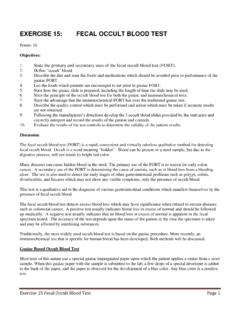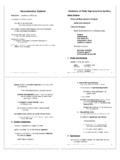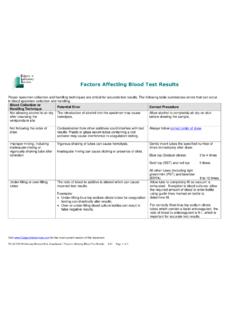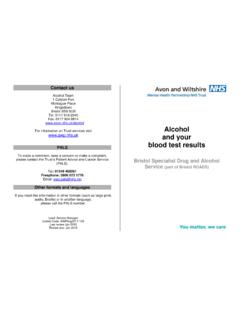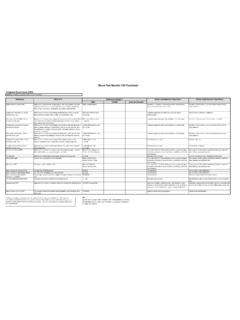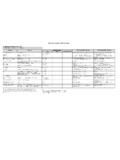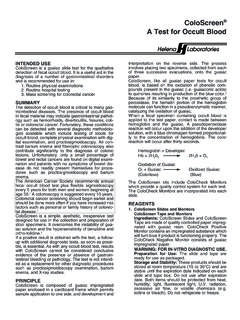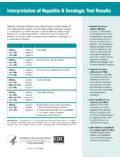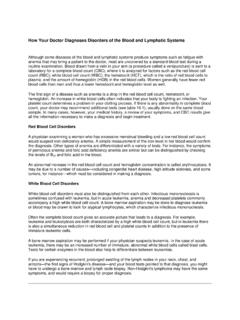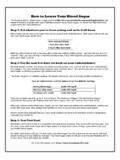Transcription of BLOOD TEST CLINICAL SIGNIFICANCE
1 BLOOD TEST CLINICAL SIGNIFICANCE The listings below discuss a few of the more common things measured in chemistry and hematology tests and their CLINICAL SIGNIFICANCE . tests CLINICAL SIGNIFICANCE NORMAL RANGE PROFILES LYTES Centrifuge specimen and refrigerate if pickup time is more than 2 hrs. Why get tested? To detect a problem with the body s electrolyte balance When to get tested? As part of routine health screening, or when your doctor suspects that you have an excess or deficit of one of the electrolytes (usually sodium or potassium), or if your doctor suspects an acid-base imbalance NA: 132-142 mmol/L K: mmol/L CL: 101-111 mmol/L CO2: 21-31 mmol/L Anion Gap: 6-16 BASIC METABOLIC PANEL (BMP) Centrifuge specimen and refrigerate if pickup time is more than 2 hrs.
2 The Basic Metabolic Panel (BMP) is a group of 8 tests (or sometimes 7 tests ) that is ordered as a screening tool to check for conditions, such as diabetes and kidney disease. The BMP uses a tube of BLOOD collected by inserting a needle into a vein in your arm. Fasting for 10 to 12 hours prior to the BLOOD draw may be preferred. The BMP is often ordered in the hospital emergency GLUC: 60-110 mg/d BUN: 8-24 mg/dL CRET: mg/dL CA: mg/dL NA: 132-142 mmol/L K: mmol/L CL: 101-111 mmol/L CO2: 21-31 mmol/L Anion Gap: 6-16 BASIC METABOLIC PANEL (BMP) (CON T) room setting because its components give your doctor important information about the current status of your kidneys, electrolyte and acid/base balance, and BLOOD sugar level. Significant changes in these test results can indicate acute problems, such as kidney failure, insulin shock or diabetic coma, respiratory distress, or heart rhythm changes.
3 The BMP is also used to monitor some known conditions, such as hypertension and hypokalemia (low potassium level). If your doctor is interested in following two or more individual BMP components, he may order the entire BMP because it offers more information. Alternatively, he may order an electrolyte panel to monitor your sodium, potassium, chloride, and CO2. If your doctor wants even more information, he may order a complete metabolic panel. COMPREHENSIVE METALBOIC PANEL (CMP) Centrifuge specimen and refrigerate if pickup time is more than 2 hrs. The Comprehensive Metabolic Panel (CMP) is a frequently ordered group of 14 tests that gives your doctor important information about the current status of your kidneys, liver, and electrolyte and acid/base balance as well as of your GLUC: 60-110 mg/d BUN: 8-24 mg/dL CRET: mg/dL TBIL: mg/dL ALKP: 49-142 IU/L SGOT: 16-49 IU/L SGPT: 10-60 IU/L TP: g/dL ALB: g/dL CA: mg/dL COMPREHENSIVE METALBOIC PANEL (CMP) (CON T) BLOOD sugar and BLOOD proteins.
4 Abnormal results, and especially combinations of abnormal results, can indicate a problem that needs to be addressed. The CMP is used as a broad screening tool to check for conditions such as diabetes, liver disease, and kidney disease. It is also used to monitor complications of diseases or side effects of medications used to treat diseases. The CMP is routinely ordered as part of a BLOOD work-up for a medical exam or yearly physical and is collected by inserting a needle into a vein in your arm. Usually fasting for 10 to 12 hours prior to the BLOOD draw is preferred. While the tests are sensitive, they do not usually tell your doctor specifically what is wrong. Abnormal test results or groups of test results are usually followed-up with other specific tests to confirm or rule out a suspected diagnosis. The CMP is also used to monitor some known problems, such as hypertension, and drug therapies, such as cholesterol-lowering drugs.
5 If your doctor is interested in following two or more individual CMP components, s/he may order the entire CMP because it NA: 132-142 mmol/L K: mmol/L CL: 101-111 mmol/L CO2: 21-31 mmol/L Anion Gap: 6-16 COMPREHENSIVE METALBOIC PANEL (CMP) (CON T) offers more information. LIPID PANEL The lipid profile is a group of tests that are often ordered together to determine risk of coronary heart disease. The tests that make up a lipid profile are tests that have been shown to be good indicators of whether someone is likely to have a heart attack or stroke caused by blockage of BLOOD vessels (hardening of the arteries). TGL: mg/dL Normal= <150 Borderline = 150-199 High = 200-499 Very High = >500 CHOL: mg/dL Desirable <200 Borderline 200-239 High > or = 240 HDL: 40-59 mg/dL Cal. LDL: mg/dL Optimal <100 Near 100-129 Borderline 130-159 High 160-189 Very High >190 LIVER PANEL A liver panel, also known as liver (hepatic) function tests or LFT, is used to detect liver damage or disease.
6 It usually includes seven tests that are run at the same time on a BLOOD sample. TBIL: mg/dL DBIL: mg/dL IBIL: mg/dL ALKP: 49-142 IU/L SGOT: 16-49 IU/L SGPT: 10-60 IU/L ALB: g/dL CHEMISTRY ALBUMIN INCREASED absolute serum albumin content is not seen as a natural condition. Relative increase may occur in hemoconcentration. Absolute increase may occur artificially by infusion of hyperoncotic albumin suspensions. DECREASED serum albumin is seen in states of decreased synthesis (malnutrition, malabsorption, liver disease, and other chronic diseases), increased loss (nephritic syndrome, many GI conditions, thermal burns, etc.), and increased catabolism (thyrotoxicosis, g/dL ALBUMIN (CON T) cancer chemotherapy, Cushing s disease, familial hypoproteinemia).
7 ALKALINE PHOSPHATASE INCREASED serum alkaline phosphatase is seen in states of increased osteoblastic activity (hyperparathyroidism, osteomalacia, primary and metastatic neoplasms), hepatobiliary diseases characterized by some degree of intra- or extrahepatic cholestasis, and in sepsis, chronic inflammatory bowel disease, and thyrotoxicosis. Isoenzymes determination may help determine the organ/tissue responsible for an alkaline phosphatase elevation. DECREASED serum alkaline phosphatase may not be clinically significant. However, decreased serum levels have been observed in hypothyroidism, scurvy, kwashiorkor, achrondroplastic dwarfism, deposition of radioactive materials in bone, and in the rare genetic condition hypophosphatasia. There are probably more variations in the way in which alkaline phosphatase is assayed than any other enzyme.
8 Therefore, the reporting units vary from place to place. The reference range for the assaying laboraotory must be carefully studied when interpreting any individual result. 49-142 IU/L ALT (SGPT) INCREASE of serum alanine aminotransferase (ALT, formerly called SGPT ) is seen in any condition involving necrosis of hepatocytes, myocardial cells, erythrocytes, or skeletal muscle cells. 10-60 IU/L AMYLASE Why get tested? To diagnose pancreatitis or other pancreatic diseases When to get tested? If you have symptoms of a pancreatic disorder, such as severe abdominal pain, fever, loss of appetite, or nausea 25-125 U/L AST (SGOT) INCREASE of aspartate aminotransferase (AST, formerly called SGOT ) is seen in any condition involving necrosis of hepatocytes, myocardial cells, or skeletal muscle cells. DECREASED serum AST is of no known CLINICAL SIGNIFICANCE .
9 16-49 IU/L ASO, TITER Antistreptolysin O (ASO) titer is a BLOOD test used to help diagnose a current or past infection with Group A strep (Streptococcus pyogenes). It detects antibodies to streptolysin O, one of the many strep antigens. This test is rarely ordered now compared to thirty years ago. For an acute strep throat infection, this test is not performed; the throat culture is used. However, if a doctor is trying to find out if someone had a recent strep 0-100 IU/mL ASO, TITER (CON T) infection that may not have been diagnosed, this test could be helpful. In addition, it may be used to help diagnose rheumatic fever, which occurs weeks after a strep throat infection when the throat culture would no longer be positive. BUN Serum urea nitrogen (BUN) is INCREASED in acute and chronic intrinsic renal disease, in state characterized by decreased effective circulating BLOOD volume with decreased renal perfusion, in postrenal obstruction of urine flow and in high protein intake states.
10 DECREASED serum urea nitrogen (BUN) is seen in high carbohydrate/low protein diets, states characterized by increased anabolic demand (late pregnancy, infancy, acromegaly), malabsorption states and severe liver damage. 8-24 mg/dL TOTAL BILIRUBIN DIRECT BILIRUBIN INDIRECT BILIRUBIN Serum total bilirubin is INCREASED in hepatocellular damage (infectious hepatitis, alcoholic and other toxic hepatopathy, neoplasms), intra- and extrahepatic biliary hemolysis, physiologic neonatal jaundice, Crigler-Najjar syndrome, Gilbert s disease, Dubin-Johnson syndrome, and fructose intolerance. Disproportionate TBIL: mg/dL DBIL: mg/dL IBIL: mg/dL TOTAL BILIRUBIN DIRECT BILIRUBIN INDIRECT BILIRUBIN (CON T) ELEVATION of direct (conjugated) bilirubin is seen in cholestasis and late in the course of chronic liver disease. Indirect (unconjugated) bilirubin tends to predominate in hemolysis and Gilbert s disease.
